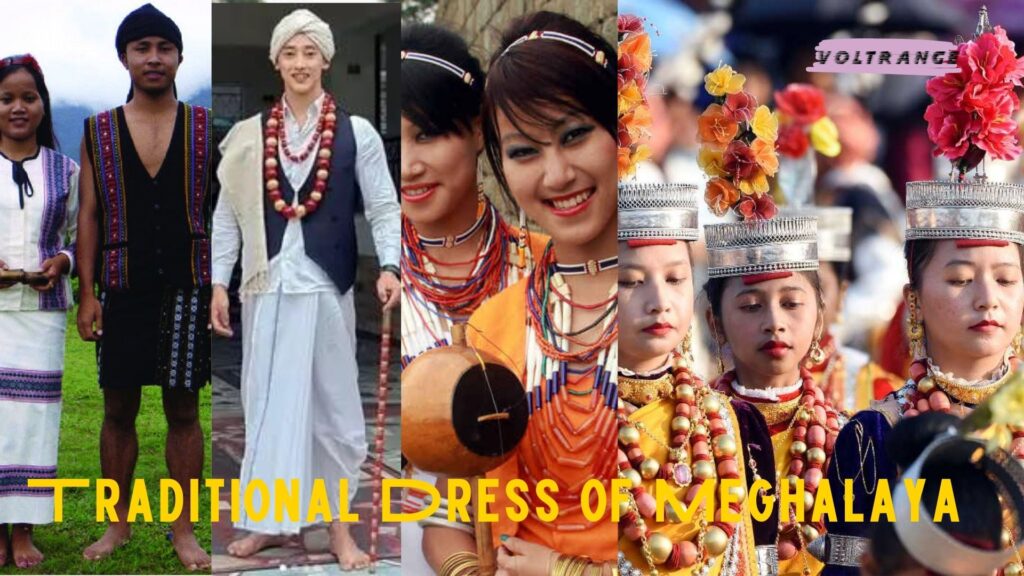
Traditional Dress of Meghalaya
Meghalaya, one of India’s most breathtaking northeastern states, aptly earns its name, which translates to “the abode of the clouds.” Rich in culture and history, legends say that the state’s roots trace back to 16 families—nine descended from heaven and seven from earth. Today, Meghalaya is home to various indigenous tribes, including the Jaintia, Khasi, and Garo, each preserving their unique traditions and way of life.
Among the many customs that continue to thrive in Meghalaya, weaving stands out as one of the oldest and most respected professions. The Garo tribe, in particular, has earned a reputation for its skilled artisans, producing intricate woven garments. Across the state, the traditional attire reflects the tribes’ deep connection to their heritage, with both men and women proudly displaying their cultural identity through their clothing. Even in the modern era, many people in Meghalaya continue to honor their traditional roots. In this article, we’ll explore the traditional dress of Meghalaya for both men and women.
Traditional Dress of Meghalaya Men
The traditional attire of men in Meghalaya varies among the different tribes, particularly between the Jaintia, Khasi, and Garo tribes.
- Jaintia and Khasi Tribes: Men from these tribes commonly wear a long, unstitched dhoti, wrapped around the waist. This is usually paired with an embroidered jacket or shirt for special occasions. Festivals such as Ka Pom-Blang Nongkrem and Ka Shad Suk Mynsie see men donning silk turbans and sometimes carrying a ceremonial sword, adding to the festive spirit.
- Garo Tribe: The Garo men, on the other hand, wear a distinctive handwoven loincloth. While these traditional garments are primarily reserved for festivals and important events, the pride these men take in their cultural attire is evident every time they wear it.
Traditional Dress of Meghalaya Women
Women’s traditional dress in Meghalaya varies greatly between the tribes, but all are beautiful representations of their heritage.
- Jainsem: The Jainsem is a timeless traditional dress worn by women in Meghalaya. Made from mulberry silk, a fabric that is native to the state, this attire is often paired with a tap-moh khlieh, a cotton shawl worn draped over the head or shoulders.
- Kyrshah: During the harvest season, women of the Jaintia tribe wrap their heads with a checked cloth known as Kyrshah. To complete their look, they wear a rich, velvet blouse and an ankle-length sarong called Thoh Khyrwang. For special festivals, they adorn themselves with silver and gold jewelry, including the Kynjri Ksiar, a traditional gold pendant popular among the Jaintia and Khasi communities.
- Jainkup: Elderly women from the Jaintia community often wear the Jainkup, a full-sleeved woolen blouse with intricate lace embroidery around the neck. This outfit is typically paired with red coral and white bead necklaces, silver or gold crowns, and elegant earrings. It’s a favored attire during traditional performances and festivals like the Khasi Festival.
- Dak Manda: Women of the Garo tribe are often seen wearing the Dak Manda, a beautifully handwoven lungi that is wrapped around the waist. The style of dress varies based on the region. In more populated areas, Garo women prefer long cotton dresses, while in remote areas, women often wear the ‘eking,’ a smaller piece of cloth wrapped around the waist. Jewelry is also significant in the Garo tribe, with brass earrings called Nadongbi nr sisha and long necklaces like Ripok, made from red or silver beads, being particularly popular during festive occasions.
Traditional Wedding Attire in Meghalaya
For weddings, both the bride and groom wear traditional outfits that reflect their rich heritage.
- Brides: The bride typically wears a Jainsem or Dhara, made from saffron or yellow-colored mulberry silk. The outfit is adorned with a silver or gold crown, which includes a peak that extends down the back. Two contrasting fabrics are draped over the shoulders, completing the elegant look.
- Grooms: The groom traditionally wears a Jymphong, a sleeveless jacket featuring a symbolic red cock motif. The jacket is designed with a V-neckline and fastened with a Chinese frog fastener. The groom’s attire is deep blue, often decorated with golden or silver tassels, and he wears a silk Jainboh around his waist. For special occasions like weddings, Khasi men also wear a vibrant Jainspong, a turban in yellow and red.
Conclusion
Meghalaya’s diverse tribes may showcase different styles of traditional clothing, but they all share a deep respect for their cultural roots. The people of Meghalaya take immense pride in their rich heritage, and their attire—whether worn during daily life or reserved for special events—remains a testament to this. While the men’s traditional attire is often seen only during celebrations, women in Meghalaya continue to hold on to their ancient ways of dressing, keeping their traditions alive for generations to come.





More Stories
which of the following statements is true about education and lifetime earnings? Complete Guide Here
Statekaidz.com: Education with Fun For Kids 2025
Top 5 Richest States in India by GDP